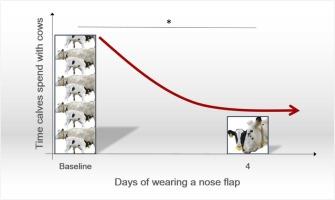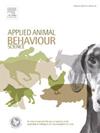Dairy calves' time spent in the cow herd in a calf-driven cow-calf contact system during two-step separation with a nose flap
IF 2.2
2区 农林科学
Q1 AGRICULTURE, DAIRY & ANIMAL SCIENCE
引用次数: 0
Abstract
Although originally developed for weaning of beef calves, nose flaps are also used on dairy farms nowadays to wean calves which are reared with contact to their dam or a foster cow. These calves are often weaned younger than beef calves and the time they wear nose flaps is highly variable, since it is unknown for how long younger calves need to wear the nose flap in order to induce an effective weaning. The aim of our study was therefore to track changes in dam-contact initiated by dairy calves after insertion of a nose flap in order to determine the minimum duration a nose flap needs to be worn to effectively reduce suckling motivation of calves. The study was conducted in two sequential experiments using 3-month-old dairy calves that were reared with full-time dam contact. Calves were weaned with a nose flap over either 14 (experiment I, 9 calves in herd A and 9 calves in herd B) or 7 days (experiment II, 11 calves in herd A and 12 calves in herd B) before they were fence-line separated from their dams. The total time a calf spent within the cow herd (TIC) per day was determined from continuous video recordings during 7 days before nose flap insertion (baseline), as well as during the 7 or 14 days in which calves had free access to the cow area while wearing the nose flap. Statistical analysis was conducted using linear mixed effects models. Results from both experiments showed that calves reduced their TIC at the fourth day of wearing the nose flap compared to their individual baseline (p=0.03 and p=0.001 respectively). In experiment I, calves showed a further numerical reduction in TIC from day 4 to day 5, while in experiment II, calves showed no further reduction in TIC after the 4 days of wearing the nose flap. After these 4 or 5 days respectively, TIC of calves in both experiments stayed at a constant low level of several hours per day. Taken together, these results indicate that in 3-month-old dairy calves it needs at least 4 days until the motivation to spend time with the cow decreases after insertion of a nose flap, while there seems to be no further decrease in motivation when using a nose flap longer than this time. However, results were subject to considerable inter-individual variability already during the baseline week and need replication in a pasture-based setting with less space-restrictions.

在犊牛驱动的母牛-犊牛接触系统中,用鼻翼进行两步分离时,奶牛犊牛在牛群中停留的时间
虽然挡鼻板最初是为肉用犊牛断奶而开发的,但现在奶牛场也使用挡鼻板为与母牛或寄养牛接触饲养的犊牛断奶。这些犊牛的断奶年龄通常比肉用犊牛小,而且它们佩戴鼻翼的时间变化很大,因为不知道小犊牛需要佩戴多长时间的鼻翼才能有效断奶。因此,我们的研究目的是跟踪奶牛犊牛在佩戴鼻翼后与母牛接触的变化,以确定佩戴鼻翼的最短时间,从而有效降低犊牛的吸吮动机。该研究使用 3 个月大的奶牛犊牛进行了两次连续实验,这些犊牛在饲养过程中与母牛保持全时接触。在犊牛与母牛进行栅栏隔离之前,给犊牛佩戴鼻翼14天(实验I,A群9头犊牛和B群9头犊牛)或7天(实验II,A群11头犊牛和B群12头犊牛)。犊牛每天在牛群中逗留的总时间(TIC)是根据插入鼻翼前 7 天(基线)以及犊牛佩戴鼻翼可自由进入牛区的 7 天或 14 天的连续视频记录确定的。统计分析采用线性混合效应模型进行。两项实验的结果表明,与各自的基线相比,小牛在佩戴鼻翼的第四天减少了TIC(分别为p=0.03和p=0.001)。在实验 I 中,从第 4 天到第 5 天,小牛的 TIC 数量进一步减少;而在实验 II 中,佩戴鼻翼 4 天后,小牛的 TIC 没有进一步减少。在这 4 天或 5 天之后,两个实验中的小牛的 TIC 都保持在每天数小时的低水平。综上所述,这些结果表明,3个月大的奶牛犊牛在佩戴鼻翼后至少需要4天才能降低与奶牛相处的积极性,而使用鼻翼的时间超过这段时间后,犊牛的积极性似乎不会进一步降低。不过,在基线周期间,个体间的差异已经很大,因此需要在空间限制较少的牧场环境中进行复制。
本文章由计算机程序翻译,如有差异,请以英文原文为准。
求助全文
约1分钟内获得全文
求助全文
来源期刊

Applied Animal Behaviour Science
农林科学-行为科学
CiteScore
4.40
自引率
21.70%
发文量
191
审稿时长
18.1 weeks
期刊介绍:
This journal publishes relevant information on the behaviour of domesticated and utilized animals.
Topics covered include:
-Behaviour of farm, zoo and laboratory animals in relation to animal management and welfare
-Behaviour of companion animals in relation to behavioural problems, for example, in relation to the training of dogs for different purposes, in relation to behavioural problems
-Studies of the behaviour of wild animals when these studies are relevant from an applied perspective, for example in relation to wildlife management, pest management or nature conservation
-Methodological studies within relevant fields
The principal subjects are farm, companion and laboratory animals, including, of course, poultry. The journal also deals with the following animal subjects:
-Those involved in any farming system, e.g. deer, rabbits and fur-bearing animals
-Those in ANY form of confinement, e.g. zoos, safari parks and other forms of display
-Feral animals, and any animal species which impinge on farming operations, e.g. as causes of loss or damage
-Species used for hunting, recreation etc. may also be considered as acceptable subjects in some instances
-Laboratory animals, if the material relates to their behavioural requirements
 求助内容:
求助内容: 应助结果提醒方式:
应助结果提醒方式:


